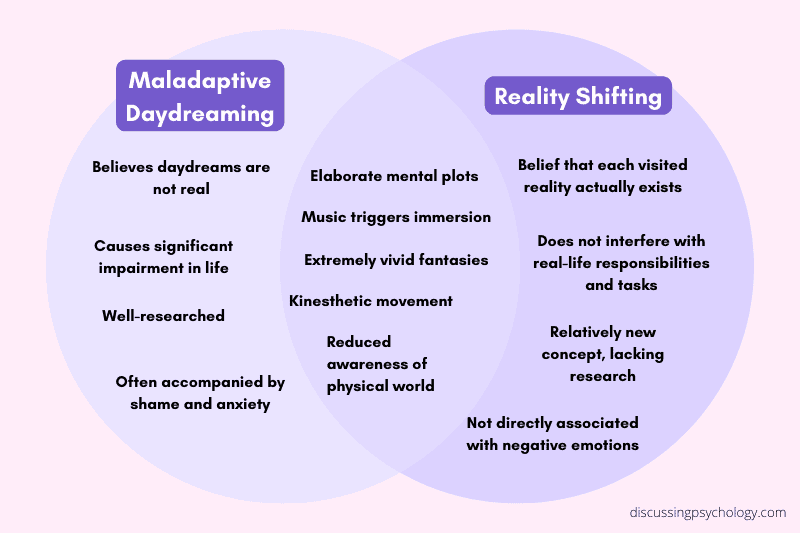Reality shifting and maladaptive daydreaming both involve deeply immersive fantasies and altered perceptions of reality that are detached from the physical world.
This can lead to some people blurring the line between each concept and assuming they are the same—which is simply not the case.
The core difference is that maladaptive daydreaming represents an unhealthy, compulsive coping mechanism often triggered by trauma, resulting in significant impairment, whereas reality shifting does not typically lead to such negative consequences.
However, the differences don’t stop there. Let’s take a closer look below.
Maladaptive Daydreaming and Reality Shifting: Differences Explained

First, however real a daydream seems and however much an individual with maladaptive daydreaming (MD) may want their dreams to be real, they aren’t. People with MD know that they are dreaming and that their fantasy worlds aren’t real.
This does not appear to always be the case for people who reality shift (RS): many believe they truly are visiting alternate realities.
Putting aside the rather philosophical question of whether such realities exist, a more important difference between the two experiences relates to the maladaptive aspect of maladaptive daydreaming.
The second core difference, is that maladaptive daydreaming causes significant impairment to people who experience it, both because of the time and focus it takes away from other activities and because the inability to control your own thoughts often leads to intense anxiety and shame.
Reality shifting, in contrast, is reported to be a highly enjoyable experience, with few of the negative consequences associated with MD.
Similarities
Despite their differences, MD and RS do share a number of commonalities, such as:
- Spending hours engaged in elaborate mental plots, often based on popular works of fiction
- Extremely vivid fantasies engaging multiple senses
- Reduced awareness of the physical world
- Use of music to trigger daydreaming and facilitate immersion
- Kinesthetic movement, such as acting out parts of the fantasy to enhance the experience
Reality Shifting: What exactly is it?
Those who practice reality shifting claim to be sending their consciousness to other realities.
Drawing on theories of multiple universes, reality shifting gained popularity as a purported way to transcend the physical body and appear in a desired alternate world.
Popular destinations include the Harry Potter and Star Wars universes, along with the worlds of various TV shows, books and video games.
The exact methods differ, but reality shifting usually involves some form of meditation or self-hypnosis in order to enter an altered state of consciousness.
This can be done by listening to meditations, following ‘scripts’ shared online, or by listening to music to enter a trance-like state.
Immersive Daydreaming
Given the absence of any negative connotations to reality shifting for the majority of practitioners, RS may be more akin to the concept of immersive daydreaming (ID).
ID, according to clinical psychologist and MD pioneer Eli Somer, is the ability to engage in vivid and elaborate fantasies for the purpose of entertainment and relaxation.
Unlike maladaptive daydreaming, immersive daydreaming would not be considered an addiction or a mental illness, and is in fact a very desirable trait.
Somer argues that the capacity for ID is, indeed, a trait that some people possess and others don’t.
The ability to engage in ID is based on one’s capacity for multiple factors, including:
- Fantasy proneness—how invested you become in works of fiction
- Dissociative absorption—the ability to become so engrossed in one aspect of consciousness that all others are ignored
- Suggestibility/hypnotisability
- Vivid imagination
Given the similarity of the two experiences, it is reasonable to assume that RS and ID are extremely closely related, if not different aspects of the same phenomenon.
Based on this assumption, Somer and colleagues developed a model of RS which incorporates one’s capacity for ID, the influence of social media, and motivations to try RS such as boredom, interest in alternate realities or a coping mechanism in response to stress.

The darker side
So is reality shifting an unusual but harmless fad being explored by bored kids who had nothing better to do during lockdown? For most, that’s probably the case.
But it’s worth bringing up a couple of risks and concerning trends which have emerged within the world(s) of reality shifting.
The line between ID and MD is often razor thin. The experience of daydreams between the two conditions is the same; the only difference is that in MD it has become an unhealthy, addictive response to trauma or stress.
As such, while ID and RS may be fun, but getting involved in them could lead to them becoming an unhelpful coping strategy that later becomes addictive.
Blurring fantasy and reality
Some former reality shifters found that they had to stop the practice as it had become too all-encompassing, and they were neglecting other areas of their life, similar to the experiences of people with MD.
For others, reality shifting produces such a rush of pleasure that giving it up is seen as untenable, and they would rather sever ties with this reality than stop.
In a subset of reality shifters, the rather alarming concept of respawning has emerged: permanently leaving your body behind and fully living in your alternate world.
In some cases this involves physically dying so that your mind can leave the physical world.
Interest in this idea is relatively minor compared to RS overall, but it does highlight the danger inherent in blurring the lines between fantasy and reality.
If you believe it is possible to enter a fantasy world where everything is as you want it to be whenever you want to, what reason would you ever have for wanting to come back?
- Colombo, C. (2022, January 26). 'Reality shifting' where users say they're transported to another life has exploded on TikTok, but former shifters say it harmed their mental health. Insider. https://www.insider.com/shifttok-reality-shifting-respawn-amino-reddit-tumblr-instagram-twitter-tiktok-2021-12
- Somer, E., Cardeña, E., Catelan, R., & Soffer-Dudek, N. (2021). Reality shifting: Psychological features of an emergent online daydreaming culture. Current Psychology. https://doi.org/10.1007/s12144-021-02439-3
- Somer, E (2021, November 10). Maladaptive Daydreaming and Reality Shifting . Retrieved from: https://www.youtube.com/watch?v=f5T1afG9FE4&ab_channel=SomerClinic

